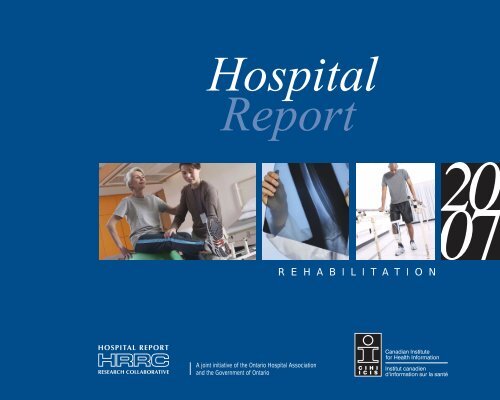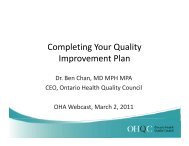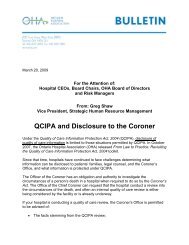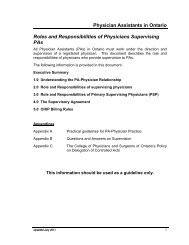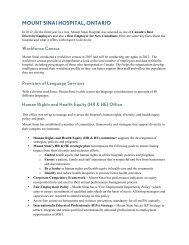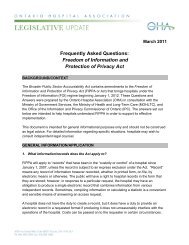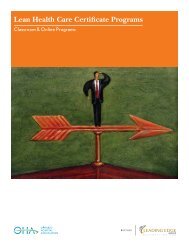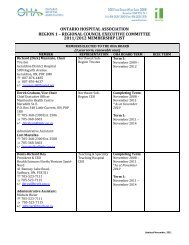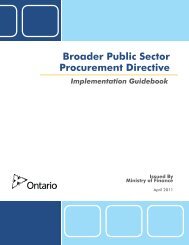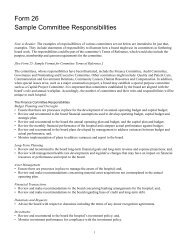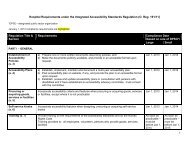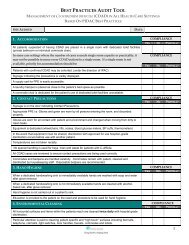R E H A B I L I T A T I O N - Ontario Hospital Association
R E H A B I L I T A T I O N - Ontario Hospital Association
R E H A B I L I T A T I O N - Ontario Hospital Association
You also want an ePaper? Increase the reach of your titles
YUMPU automatically turns print PDFs into web optimized ePapers that Google loves.
<strong>Hospital</strong>ReportR E H A B I L I T A T I O NA joint initiative of the <strong>Ontario</strong> <strong>Hospital</strong> <strong>Association</strong>and the Government of <strong>Ontario</strong>
CONTENTSPAGEThis report is brought to you by theGovernment of <strong>Ontario</strong> in partnershipwith the <strong>Ontario</strong> <strong>Hospital</strong> <strong>Association</strong>.About This ReportiiA Snapshot of <strong>Hospital</strong> Activity in <strong>Ontario</strong>’s LHINs 1A Balanced Scorecard 4High-Performing <strong>Hospital</strong>s Within Quadrants 5Interpreting the Results 6System Integration and Change 9Indicator Definitions 9Summary of Results 10Performance Allocation Table 15Client Perspectives 19Indicator Definitions 19Summary of Results 20Performance Allocation Table 22Clinical Utilization and Outcomes 26Indicator Definitions 26Summary of Results 28Performance Allocation Table 33Financial Performance and Condition 36Indicator Definitions 36Summary of Results 38Performance Allocation Table 39Appendix A: Data Sources 42
A SNAPSHOT OF HOSPITAL ACTIVITYIN ONTARIO’S LHINSLocal Health Integration Networks (LHINs)Figure 1. <strong>Ontario</strong>’s Rehabilitation <strong>Hospital</strong>s by LHIN1 Erie St. Clair2 South West3 Waterloo Wellington4 Hamilton Niagara Haldimand Brant5 Central West6 Mississauga Halton7 Toronto Central8 Central9 Central East10 South East11 Champlain12 North Simcoe Muskoka13 North East14 North WestPAGE 1
This section highlights selected characteristics of local healthintegration networks (LHINs), providing context for interpretationof the rehabilitation indicator results.Table 1 shows the proportion of inpatient rehabilitation clientsby LHIN and lists the number of hospitals that provide inpatientrehabilitation services by facility type in each LHIN. Facilitiesparticipating in the National Rehabilitation Reporting System (NRS)are classified as either General or Specialty. This classification isspecific to the NRS and is intended to facilitate comparative reporting;it is not necessarily consistent with facility classification methodsused for ministry reporting in <strong>Ontario</strong> (that is, the Ministry of Healthand Long-term Care Master Number List).As defined for the NRS, a general rehabilitation facility is a rehabilitationunit or collection of beds designated for rehabilitation purposes thatis part of a general hospital offering multiple levels or types of care.A specialty rehabilitation facility is one that provides more extensiveand specialized inpatient rehabilitation services and is commonlya free-standing facility or a specialized unit within a hospital. Therehabilitation team at the facility decides which profile most closelyrepresents its rehabilitation program(s) and categorizes itself asgeneral or specialty when beginning submissions to the NRS.Note that it is possible for a hospital to have more than one facility, andit is also possible for a hospital to have both a specialty rehabilitationfacility and a general facility with rehabilitation beds. This is illustratedin the above table under the column “<strong>Hospital</strong>s With Both Types.”Table 1.Inpatient Rehabilitation in <strong>Ontario</strong>LHINPercent ofInpatientRehabilitationClientsin <strong>Ontario</strong>Specialty<strong>Hospital</strong>sGeneral<strong>Hospital</strong>s<strong>Hospital</strong>sWith BothFacilityTypes1 Erie St. Clair 6.2 1 4 0 52 South West 4.8 1 4 0 53 Waterloo Wellington 4.6 0 4 0 44 Hamilton Niagara Haldimand Brant 8.9 0 4 1 55 Central West 0.5 0 1 0 16 Mississauga Halton 9.0 0 3 0 37 Toronto Central 21.6 3 5 0 88 Central 18.1 1 5 0 69 Central East 9.0 0 6 0 610 South East 1.9 0 1 1 211 Champlain 9.9 1 4 1 612 North Simcoe Muskoka 1.4 0 2 0 213 North East 2.0 1 3 0 414 North West 2.3 0 0 1 1<strong>Ontario</strong> 100 8 46 4 58TotalPAGE 2
Table 2 depicts the total number of stroke,orthopedic and other inpatient rehabilitationclients in <strong>Ontario</strong> in 2005–2006, by LHIN. Together,the Toronto Central LHIN and the Central LHINaccount for almost half (40%) of all inpatientrehabilitation clients. <strong>Hospital</strong>s in these LHINshad the lowest percentage of stroke clients (10%and 6%, respectively) and were among hospitalswith the highest percentage of orthopedicconditionclients (59% and 71%, respectively)when compared with other LHINs. By contrast,hospitals in the North East LHIN had the highestproportion of stroke clients (34%) and the lowestproportion of orthopedic-condition clients (22%).When making comparisons across LHINs, itis important to consider the varying numberof hospitals in each LHIN. Other factorsalso contribute to differences among LHINs(for example, population density, rural versusurban, hospital type). Where variation in indicatorresults is observed, further investigation iswarranted to explore the opportunities for sharedlearning and process improvement. Theperformance allocation tables that follow thesummary of results for each section of the reportprovide LHIN averages for each of the indicators.Table 2.Number Orthopedic Otherof Inpatient Stroke Conditions RCGsRehabilitationClients inLHIN <strong>Ontario</strong> Number Percent Number Percent Number Percent1 Erie St. Clair 1,714 387 22.6 739 43.1 588 34.32 South West 1,322 327 24.7 459 34.7 536 40.63 Waterloo Wellington 1,268 127 10.0 447 35.3 694 54.74 Hamilton NiagaraHaldimand BrantNumber and Percent of Stroke, Orthopedic Conditions and Other InpatientRehabilitation Clients in <strong>Ontario</strong> by LHIN, 2005–20062,457 549 22.3 865 35.2 1,043 42.55 Central West 138 17 12.3 114 82.6 7 5.16 Mississauga Halton 2,501 297 11.9 1,496 59.8 708 28.37 Toronto Central 5,974 565 9.5 3,532 59.1 1,877 31.48 Central 5,005 318 6.4 3,552 71.0 1,135 22.69 Central East 2,484 374 15.1 1,586 63.8 524 21.110 South East 517 133 25.7 226 43.7 158 30.611 Champlain 2,741 436 15.9 1,274 46.5 1,031 37.612 North Simcoe Muskoka 386 111 28.8 184 47.7 91 23.513 North East 542 182 33.6 121 22.3 239 44.114 North West 645 74 11.5 402 62.3 169 26.2<strong>Ontario</strong> 27,694 3,897 14.1 14,997 54.2 8,800 31.8Source: National Rehabilitation Reporting System, 2005–2006, CIHI.PAGE 3
A BALANCED SCORECARDWHAT IS ABALANCED SCORECARD?Providing care in a health care facility is a complexactivity involving a multitude of skills, experiencesand technologies. No single aspect of the systemcauses poor or excellent hospital performance. Forthis reason, performance-measurement activities mustinclude measures that provide insights into multipledimensions of a hospital’s performance. The balancedscorecard approach describes performance across fourdimensions or quadrants critical to the strategic successof any health care organization. These quadrantsinclude: System Integration and Change, ClientPerspectives, Clinical Utilization and Outcomesand Financial Performance and Condition.Performance measures for each of the four quadrantsare provided at the hospital-specific level, along withaverage scores by LHIN and the province as a whole.While all hospitals’ values are used in calculatingaverage results by LHIN and the province, hospitalspecificvalues are shown for hospitals that hadsufficient data and agreed to have their resultspublished for quality improvement purposes. Thisyear, 57 out of 58 (98%) hospitals with designatedrehabilitation beds participated in at least onequadrant and 37 (64%) hospitals participatedin all four quadrants of the report.Using a balanced scorecard format, this report providesa summary of performance scores for 23 indicatorsacross four areas of performance.System Integration and ChangeSYSTEM INTEGRATION AND CHANGEThis quadrant focuses on indicators that assess efforts and investments that hospitalsneed to make in order to improve the delivery of adult inpatient rehabilitation services.It measures the extent to which best practices and the involvement of different players arenecessary for making decisions about care, and implementing a client-centred approachto service delivery. [9 indicators]Client PerspectivesCLIENT PERSPECTIVESThis quadrant describes clients’ perceptions of the care they received during inpatientrehabilitation. For participating hospitals, surveys were mailed to clients following theirdischarge from hospital asking them to rate the care they received related to severalcomponents of client-centred rehabilitation, including participation in decision-making andgoal-setting, evaluation of outcomes from the client’s perspective and family involvementin care. [8 indicators]Clinical Utilization and OutcomesCLINICAL UTILIZATION AND OUTCOMESThis quadrant presents indicators that evaluate hospitals’ clinical performance for clientsthat are cared for in designated adult inpatient rehabilitation beds. The indicators, fromthe National Rehabilitation Reporting System, describe changes in the Total FunctionScore i as measured by the FIM TM instrument, length of stay and length of stay efficiency.Indicators are reported for the following Rehabilitation Client Groups (RCGs) ii : All RCGs,Stroke and Orthopedic Conditions. [3 indicators]Financial Performance and ConditionFINANCIAL PERFORMANCE AND CONDITIONThis quadrant describes selected measures of efficiency and productivity in hospitals withdesignated rehabilitation beds. [3 indicators]i. Total Function Score referenced in this document is based on data collected using the FIM TM instrument.The 18-item FIM TM instrument referenced herein is the property of Uniform Data System for MedicalRehabilitation, a division of UB Foundation Activities, Inc.ii.Each of the three indicators are reported for the following Rehabilitation Client Groups (RCGs): All RCGs, Strokeand Orthopedic Conditions. Rehabilitation Client Groups (RCGs) adapted with permission from the UDSMRimpairment codes. Copyright 1997 Uniform Data System for Medical Rehabilitation, a division of UB FoundationActivities, Inc., all rights reserved. PAGE 4
“HIGH-PERFORMING” HOSPITALSHIGH-PERFORMING HOSPITALS WITHIN QUADRANTSSystem Integration and ChangeSYSTEM INTEGRATION AND CHANGECriteriaHighest score (or 100) on one indicatorand above-average rating for at least 4 of 9indicators and no below-average rating.High Performing <strong>Hospital</strong>s- The Credit Valley <strong>Hospital</strong>Client PerspectivesCLIENT PERSPECTIVESCriteriaAbove average on 6 of 8 indicators and nobelow-average score on any indicator.High Performing <strong>Hospital</strong>s- Providence Continuing Care Centre- Sisters of Charity of Ottawa (SCO)Health Service- St. Joseph’s Health Care London- The Ottawa <strong>Hospital</strong>- West Park Healthcare CentreClinical Utilization and OutcomesCLINICAL UTILIZATION AND OUTCOMESCriteriaAbove-average rating on Total FunctionChange, average or above-average ratingon Average Active Rehabilitation Length ofStay and average or above-average ratingon Length of Stay Efficiency for at least oneof the following RCGs: All RCGs, Stroke,Orthopedic Conditions or the sub-categorieswithin Orthopedic Conditions, Post HipFracture or Post Hip and Knee Replacement.High Performing <strong>Hospital</strong>s- Hôtel-Dieu Grace <strong>Hospital</strong>- Humber River Regional <strong>Hospital</strong>- Joseph Brant Memorial <strong>Hospital</strong>- Pembroke Regional <strong>Hospital</strong>- St. John’s Rehab <strong>Hospital</strong>- St. Mary’s General <strong>Hospital</strong>- The Credit Valley <strong>Hospital</strong>- Trillium Health CentreFinancial Performance and ConditionFINANCIAL PERFORMANCE AND CONDITIONCriteriaThere are no high-performing criteria for theFinancial Performance and Condition quadrant.For quality improvement purposes, the<strong>Hospital</strong> Report series has developedmethodologies to identify “highperforming”hospitals within three ofthe quadrants in rehabilitation care.It is useful to highlight hospitals thatperformed well in particular quadrantswhen compared to their peers, becausethese hospitals may be able to shareuseful ideas and best practices with otherhospitals within the specific areas of focus.It is interesting to note that no hospitalswere identified as high performing acrossall three quadrants. This illustrates theimportance of using a variety of measures,such as a balanced scorecard approach,when looking at hospital performance.Good performance in one quadrant doesnot necessarily translate into goodperformance in another quadrant.In addition, high performance in a givenyear relates only to how hospitals performbased on the indicators calculated for thatparticular year. High performance is notnecessarily a predictor of high-performingstatus in future years.High-performing hospitals are listedin alphabetical order.PAGE 5
INTERPRETING THE RESULTSAs there can be competing interests and incentives in the management of hospitals to maximizeboth quality and efficiency and maintain a balance of resources in the context of limited resources,no single indicator or quadrant should be used to assess a hospital. All aspects of performanceare important. One indicator on its own will provide an incomplete picture of overall performance.The indicator results in this report should be viewed as screening tests that can identify potentialopportunities for quality improvement. In medicine, screening tests do not provide a definitivediagnosis, but can help to identify patients that require follow-up. Similarly, comparisons of indicatorresults may not offer a definitive assessment of a hospital’s performance. Further investigative workis required by hospitals to better understand the factors underlying their results and identifyspecific strategies or areas for improvement.There are many factors that can cause indicator values to vary from hospital to hospital. Someof these factors, such as the diversity in patient characteristics and the populations served arebeyond a hospital’s control. For this reason, comparisons of indicator scores among hospitals andLHINs should be made with caution. It is also important to exercise caution when examining yearto-yearchanges in indicator values. This is because the methodology used to calculate indicatorsis reviewed annually, and in some cases, changes are made to improve the methodology overtime. There are certain instances where risk adjustment is not warranted as it does not entirelyeliminate the impact of other factors. As in previous years, rehabilitation indicators were presentedunadjusted, as it has been shown that there is no significant impact on mean scores.Where Can You Find MoreInformation?Further information is available in thetechnical summaries, which can beaccessed through the <strong>Hospital</strong> Reportwebsite at www.hospitalreport.ca.The technical summaries provide moredetailed definitions of the indicatorsand the statistical methods used tocalculate the results.PAGE 6
INTERPRETATION OF BOX PLOTS AND PERFORMANCE ALLOCATION TABLESInterpreting Box PlotsFor each quadrant, a summary of the distribution of the hospital values for the indicators is presentedgraphically using a box plot. <strong>Hospital</strong>s can use these graphs to determine where their indicator valuesfall relative to other hospitals’, the median value and the provincial average.Figure 2 is a sample box plot.The vertical line in the shaded box represents the median value; this is the value at which half ofhospitals’ scores are higher and half are lower.The shaded box represents the interquartile range (IQ); the middle 50% of hospital values will becontained in this range.The whiskers or lines beyond the shaded box extend to the largest and smallest values, excludingoutliers. That is, they contain approximately the top 25% and bottom 25% of hospital values.Outliers, hospital values that are considerably different from the others, are identified by circles,and extreme outliers are identified by stars.The provincial average (38.3%) is displayed to the right of the graph.Example Box PlotMedian(midpoint)LowerQuartile(25th percentile)SmallestObservationUpperQuartile(75th percentile)LargestObservationProvincialAverageIndicator XWhiskerWhiskerOutliersExtreme Outliers38.3%1.5 x IQIQInterquartileRange3 x IQ0 20406080Percent100Figure 2PAGE 7
Interpreting Performance Allocation TablesThe performance allocation tables in this report show the indicator values for each hospitalparticipating in that quadrant of the report. Also included is a shaded background that indicateswhether the hospital’s score on that indicator reflected above-average performance, averageperformance or below-average performance. For more detailed information on the methodologiesused to assign hospital performance, please see the technical summaries provided on the<strong>Hospital</strong> Report website at www.hospitalreport.ca.Coloured shading for performance is assigned as follows:The hospital’s score reflected above-average performance.The hospital’s score reflected average performance.The hospital’s score reflected below-average performance.For some indicators, lower values suggest better performance.In these cases, lower values are labeled as above average.Some results are not shown, this is explained by the following symbol.NR Means non-reportable—some results are not shown to protect patient orphysician confidentiality, because the number of events was too low toobtain a reliable estimate or due to a data quality issue.Performance AllocationThe method of assignment of performanceallocation varies based on the quadrant.For Clinical Utilization and Outcomes andSystem Integration and Change, hospitals’scores were compared to the provincialaverage for all measures. For ClientPerspectives, hospitals’ scores werecompared to the provincial performancetarget for all measures (see technicalsummary for further details). Performanceallocations are not calculated for theindicators in the Financial Performanceand Condition quadrant.PAGE 8
SYSTEM INTEGRATION AND CHANGEINTEGRATION AND CHANGESYSTEM INTEGRATION AND CHANGEThe System Integration and Change (SIC) quadrant focuses on indicators that assess efforts and investmentsthat hospitals need to make in order to improve the delivery of adult inpatient rehabilitation services.It measures the extent to which best practices and the involvement of different players are necessaryfor making decisions about care and implementing a client-centred approach to service delivery.Indicator DefinitionsHealthy Work Environment (Revised)The extent to which hospitals have mechanisms in place to support and promote a healthy workenvironment, thereby contributing to employees’ physical, social, mental and emotional well-being.Interdisciplinary Integration of Care (Revised)The amount of interdisciplinary integration that is occurring in the designated rehabilitation beds in<strong>Ontario</strong> hospitals.Evidence of Client-Centred CareThe extent to which care, at the level of the individual client, is being provided in a client-centred manner.Best Practices (Revised)The extent to which a best practice approach is utilized, involving integrating information from clientsand/or family members and individual clinical experience/expertise with the best available evidence inmaking decisions about the care of individual clients.Coordination and Continuity of Care Across the ContinuumThe degree of coordination and continuity evident for clients who are discharged from inpatientrehabilitation settings.Evidence of Organizational Client-Centredness (Revised)The extent to which hospitals implement a client-centred approach to service delivery at the system level.Organizational Commitment to Staff Development (Revised)The extent to which there is organizational support for professional development, continuing educationactivities and performance evaluations for staff allocated to designated rehabilitation beds.Data presented are based on resultsfrom a survey completed on a voluntarybasis by hospital managers in February2007. Results for the 56 hospitals thatcompleted this year’s SIC rehabilitationsurvey are included in the analysisand illustrated in the performanceallocation tables.The introduction of a web-based SICsurvey allowed for a more streamlinedprocess for hospitals to submit theirresponses. Please note that there havealso been significant changes in theindicator weights and methodologiesand performance allocation methods.Caution should be taken when trendingindicator results from previous years.For a complete listing of all the changesintroduced this year, please refer to thisyear's SIC technical summary (availableat www.hospitalreport.ca).This year, the Healthy Work Environmentindicator has been included in all sectors(that is, Emergency Department Care,Complex Continuing Care, Rehabilitationand Acute Care). <strong>Hospital</strong>s thatparticipated in multiple sectors havethe same Healthy Work Environmentscore across all sectors. However, theprovincial average and performanceallocation for this indicator is notconsistent because it includes onlyparticipating hospitals within that sector.PAGE 9
SUMMARY OF RESULTSDistribution of System Integration and Change Provincial Indicator ResultsHealthy Work EnvironmentInterdisciplinary Integration of CareProvincialAverage74.573.1For moreinformation on theinterpretation of boxplots, please refer tothe Interpreting theResults section inthis report.Evidence of Client-Centred Care74.0SYSTEM INTEGRATION AND CHANGEBest PracticesCoordination and Continuity of CareAcross the Continuum—All RCGsCoordination and Continuity of CareAcross the Continuum—Total StrokeCoordination and Continuity of CareAcross the Continuum —Total Orthopedic ConditionsEvidence of Organizational Client-CentrednessOrganizational Commitment to Staff Development61.365.464.662.268.679.502040Score6080100Source: <strong>Hospital</strong> Report 2007: SIC Survey.Figure 3Figure 3 depicts the distribution of scores and the provincial average (mean) for each of the indicators. There isconsiderable variation in scores for the majority of the indicators. <strong>Hospital</strong>s can use this figure to see where theirscores (found in the performance allocation tables) for each of the indicators fall relative to other hospitals’ scoresin the province. This figure is not meant to facilitate comparison between indicators.PAGE 10
SUMMARY OF RESULTS (CONT’D)SYSTEM INTEGRATION AND CHANGEThe results from this year’s survey on System Integration and Change highlight hospitals’commitment to staff development and quality of care. <strong>Hospital</strong>s strive to ensure thereare designated staff roles in the hospital to provide quality care for patients. This year,approximately 80% of hospitals indicated that they had a formal process to designatesomeone from the multidisciplinary team to every patient to address questions andconcerns about care, goals, treatment and discharge decisions. Although there isconsiderable variation among hospitals, the results indicate that there are an increasingnumber of hospitals that are implementing a client-centred approach to service delivery atthe system level.Almost two-thirds (64%) of hospitals surveyed reported that they had a formal process inplace to educate staff on the use of models and frameworks to guide best practices withina client-centred context. Best practices involve integrating information from patients, familymembers and clinical experience/expertise with the best available evidence in makingdecisions about the care of individual patients. A similar proportion of hospitals (64%) alsohad a formal process in place for developing and/or adapting clinical practice guidelines.The variation in this indicator suggests that there are still opportunities for hospitals toimplement formal processes to support the integration of best practices.PAGE 11
SUMMARY OF RESULTS (CONT’D)SYSTEM INTEGRATION AND CHANGEThis year’s results indicatethat hospitals are frequentlyimplementing a client-centredapproach to service delivery atthe system level. One of the waysof measuring a client-centredapproach is through the use anddissemination of patient/familyfeedback. Figure 4 illustrates thathospitals are most frequently usingand sharing their results with theirmanagement team, hospital staffand board committees. The useand dissemination of patientsatisfaction data to communities,patients and families is very lowcompared to the use and disseminationto health professionals.Although hospital scores show awide variation, hospitals in generalcan continually improve their levelsof sharing and disseminating datawith their communities and withcurrent/former patients and families.How they share and use theinformation are also key aspectsin improving quality of patient care.Use and Dissemination of Patient Satisfaction Data via Verbal Presentation and Discussion of ResultsCurrent or Former Patientsand FamiliesCommunity at LargeStaff/Committee Focusedon Quality ImprovementPatient Care and Other<strong>Hospital</strong> StaffPhysiciansManagement TeamThe Board or BoardCommitteesSource: <strong>Hospital</strong> Report 2007: SIC Survey.0 20 40 60 80 100Percent of <strong>Hospital</strong>sFigure 4PAGE 12
SUMMARY OF RESULTS (CONT’D)SYSTEM INTEGRATION AND CHANGETracking clinical documentationis a key concept in promotingintegration of care within thehospital. This year’s resultsindicate that hospitals’ staff areutilizing different methods in theirclinical documentation in the clinicalrecord. Figure 5 illustrates that onlya small percentage of hospitalsdo not have a process in placefor tracking their clinicaldocumentation in the clinicalrecord. Currently, most hospitalsare tracking their clinicaldocumentation via paper-basedmethods. It is important thathospitals continually findopportunities to standardize theirways of tracking clinicaldocumentation as it promotescontinuity, interdisciplinaryteamwork within all hospitalstaff and hospital awareness ofincreasing access to information.Processes Currently Utilized for Clinical Documentation in the Clinical Recordby Staff Within Rehabilitation ServicesBoth Paper and Electronic-BasedElectronic-Based OnlyPaper-Based OnlyNo Process in PlaceIntegrated or Cross-Disciplinary DocumentationDiscipline-Specific Documentation0 20 40 60 80 100Percent of <strong>Hospital</strong>sSource: <strong>Hospital</strong> Report 2007: SIC Survey.Figure 5PAGE 13
SUMMARY OF RESULTS (CONT’D)SYSTEM INTEGRATION AND CHANGEProviding accessible information topatients and families is a key factorin promoting client-centred care.This year’s results indicate that themost frequent information availableto patients and families prior toadmission was regarding serviceswithin the hospital relevant to thecondition. Although there is informationthat is readily accessiblein most hospitals (for example,printed information on display,available at information deskor posted at bedside) withinrehabilitation services at thehospital, hospitals can enhancehow they provide information bycreating new innovative processesto provide additional informationprior to a patient’s admission(Figure 6).How to Report aComplaint orCommendationServices Within theCommunity Relevant tothe ConditionServices Within the<strong>Hospital</strong> Relevant to theConditionTaking Part in Researchor Clinical TrialsPatientAdvocate/OmbudspersonServices That SupportWellness, Improvementand Quality of LifeProviding Information to Patients/Families Prior to Admission0 20 40 60 80Percent of <strong>Hospital</strong>sSource: <strong>Hospital</strong> Report 2007: SIC Survey.Figure 6PAGE 14
PERFORMANCE ALLOCATION TABLEThe performance allocation table includes results for 56 hospitals that completed theRehabilitation SIC survey and are participating in this report.For each indicator, a higher score and above-average performance classification isinterpreted as a better result. The maximum score for each indicator is 100. As in thelast report, a three-point scale (above average, average, below average) was usedto determine performance.SYSTEM INTEGRATION AND CHANGEMethodology ChangesIn <strong>Hospital</strong> Report 2005, the method of assigning performance allocation was based oncomparing the hospital’s indicator score with the 99% confidence interval of the provincialmean for each corresponding indicator. This year, in order to be consistent with othersectors of the System Integration and Change quadrant’s performance allocationmethods, a new performance allocation method was applied. It sets the upper and lowercut-points at the 95th percentile and the 5th percentile, respectively. This method doesnot require normality, yet produces an interval similar the one obtained by mean+/- 1.645 standard deviations and should capture roughly 90% of the indicator values.<strong>Hospital</strong>s with a score at or higher than the upper cut-point are classified as above average;hospitals with a score at or less than the lower cut-point are classified as below average;and hospitals with a score between the cut points are classified as average. Using thismethod, approximately 90% of the hospitals would be classified as average.PAGE 15
SYSTEM INTEGRATION AND CHANGECommunity<strong>Hospital</strong> Served LHINCoordination Coordination Coordinationand and andContinuity Continuity Continuity Evidenceof Care of Care of Care of Organiza-Interdisci- Evidence of Across Across Across Organiza- tionalplinary Client- the the the tional CommitmentHealthy Work Integration Centred Best Continuum Continuum Continuum Client- to StaffEnvironment of Care Care Practices —All RCGs —Total Stroke —Total Ortho Centredness DevelopmentPROVINCIAL AVERAGE 74.5 73.1 74.0 61.3 65.4 64.6 62.2 68.6 79.5Baycrest Centre for Geriatric Care Toronto 7 59.7 83.3 79.6 80.0 50.0 67.5 67.5 95.9 85.0Bluewater Health Sarnia 1 87.9 52.8 60.2 40.9 55.0 55.0 55.0 57.7 47.7Bridgepoint Health Toronto 7 94.5 82.8 100.0 64.9 68.8 68.8 68.8 67.9 81.6Chatham-Kent Health Alliance Chatham 1 75.6 47.9 38.9 73.8 55.0 55.0 55.0 84.1 69.1Cornwall Community <strong>Hospital</strong> Cornwall 11 79.5 69.7 70.4 48.4 82.5 100.0 100.0 81.3 81.6Grand River <strong>Hospital</strong> Kitchener 3 44.9 81.9 69.8 91.1 63.8 72.5 72.5 45.4 72.7Grey Bruce Health Services Owen Sound 2 89.6 78.0 38.0 40.0 91.3 91.3 32.5 53.4 87.5Guelph General <strong>Hospital</strong> Guelph 3 92.7 83.1 96.3 70.7 37.5 37.5 37.5 58.3 85.0Halton Healthcare Oakville 6 100.0 89.4 71.6 83.6 65.0 65.0 65.0 89.3 74.3Hamilton Health Sciences Corporation Hamilton 4 84.0 89.9 85.0 96.0 91.3 100.0 100.0 94.1 73.8Hôpital Montfort <strong>Hospital</strong> Ottawa 11 90.0 71.1 82.2 57.3 72.5 55.0 55.0 58.2 69.1Hôpital régional de Sudbury Regional <strong>Hospital</strong> Sudbury 13 38.2 84.4 87.1 66.7 81.3 90.0 90.0 55.9 73.0Hôtel-Dieu Grace <strong>Hospital</strong> Windsor 1 96.7 69.5 69.9 64.0 92.5 92.5 92.5 56.8 100.0Humber River Regional <strong>Hospital</strong> Toronto 8 96.4 62.6 83.4 48.0 56.3 23.8 17.5 66.3 92.9Huron Perth Healthcare Alliance Stratford 2 53.5 77.1 80.6 53.3 60.0 68.8 68.8 54.9 62.0Joseph Brant Memorial <strong>Hospital</strong> Burlington 4 64.3 73.9 73.7 70.7 30.0 30.0 30.0 61.4 77.9Lakeridge Health Oshawa 9 36.4 70.8 78.3 64.0 41.3 41.3 37.5 57.7 88.8Leamington District Memorial <strong>Hospital</strong> Leamington 1 62.3 59.9 69.9 24.0 30.0 30.0 30.0 61.6 60.7Listowel and Wingham <strong>Hospital</strong>s Alliance Listowel 2 33.5 44.0 55.1 72.0 51.3 60.0 60.0 41.9 54.8Markham Stouffville <strong>Hospital</strong> Markham 8 83.2 84.6 66.4 46.7 68.8 68.8 68.8 52.9 82.2North Bay General <strong>Hospital</strong> North Bay 13 18.0 35.6 43.7 16.0 63.8 63.8 63.8 47.9 69.1North York General <strong>Hospital</strong> Toronto 8 95.8 85.8 56.9 45.8 30.0 30.0 30.0 58.5 92.9Northumberland Hills <strong>Hospital</strong> Cobourg 9 95.9 85.1 83.3 72.4 65.0 82.5 82.5 70.2 76.3Pembroke Regional <strong>Hospital</strong> Pembroke 11 89.3 75.8 75.2 48.4 60.0 68.8 68.8 88.4 85.2Penetanguishene General <strong>Hospital</strong> Inc.(The)— North Simcoe <strong>Hospital</strong> AlliancePenetanguishene 12 97.1 70.8 75.0 68.0 56.3 65.0 65.0 85.0 69.1Peterborough Regional Health Centre Peterborough 9 68.9 50.8 68.4 44.0 67.5 42.5 50.0 71.6 73.2Providence Continuing Care Centre Kingston 10 96.6 95.3 77.8 82.7 72.5 81.3 63.8 95.9 85.0Providence Healthcare Toronto 7 74.7 91.9 79.2 39.1 51.3 60.0 27.5 85.3 83.9Above-Average Performance Average Performance Below-Average PerformancePAGE 16
SYSTEM INTEGRATION AND CHANGECommunity<strong>Hospital</strong> Served LHINCoordination Coordination Coordinationand and andContinuity Continuity Continuity Evidenceof Care of Care of Care of Organiza-Interdisci- Evidence of Across Across Across Organiza- tionalplinary Client- the the the tional CommitmentHealthy Work Integration Centred Best Continuum Continuum Continuum Client- to StaffEnvironment of Care Care Practices —All RCGs —Total Stroke —Total Ortho Centredness DevelopmentQueensway Carleton <strong>Hospital</strong> Nepean 11 92.0 83.3 98.2 74.7 96.3 96.3 96.3 91.9 67.9Quinte Health Care Belleville 10 35.6 51.7 49.2 12.0 55.0 63.8 63.8 49.9 82.1Ross Memorial <strong>Hospital</strong> Lindsay 9 54.4 56.7 68.2 50.2 35.0 43.8 26.3 86.0 88.8Rouge Valley Health System Scarborough 9 70.4 71.4 57.1 32.0 63.8 63.8 63.8 83.4 88.8Royal Victoria <strong>Hospital</strong> Barrie 12 97.2 54.2 68.0 40.0 42.5 42.5 42.5 51.9 87.5Sault Area <strong>Hospital</strong> Sault Ste. Marie 13 38.3 55.6 83.2 50.7 88.8 88.8 78.8 43.1 73.2Sisters of Charity of Ottawa (SCO)Health ServiceOttawa 11 11.2 58.5 58.2 40.0 80.0 80.0 45.0 62.6 77.9Southlake Regional Health Centre Newmarket 8 34.8 68.4 68.4 61.8 50.0 25.0 67.5 54.0 88.8St. John’s Rehab <strong>Hospital</strong> Toronto 8 91.0 76.3 83.5 70.7 75.0 75.0 65.0 89.5 75.0St. Joseph’s Care Group Thunder Bay 14 39.2 81.7 98.1 76.0 91.3 100.0 96.3 46.0 77.9St. Joseph’s Health Care London London 2 97.2 85.3 87.2 92.0 100.0 100.0 82.5 94.7 88.8St. Joseph’s Health Centre Toronto Toronto 7 96.7 71.4 59.5 42.7 25.0 25.0 25.0 58.7 100.0St. Joseph’s Health Centre, Guelph Guelph 3 83.8 73.3 81.2 56.0 40.0 40.0 40.0 51.0 65.5St. Joseph’s Healthcare Hamilton Hamilton 4 98.5 79.3 82.3 79.1 82.5 82.5 82.5 59.3 85.0St. Mary’s General <strong>Hospital</strong> Kitchener 3 85.5 74.7 64.4 64.0 70.0 15.0 15.0 90.0 81.4St. Thomas-Elgin General <strong>Hospital</strong> St. Thomas 2 83.9 80.8 91.0 66.7 65.0 65.0 65.0 84.2 76.8Sunnybrook and Women’s College HealthSciences CentreToronto 7 88.6 76.8 80.6 100.0 100.0 15.0 15.0 59.9 85.9The Brantford General <strong>Hospital</strong> Brantford 4 91.9 61.4 73.3 28.0 51.3 68.8 68.8 56.2 77.9The Credit Valley <strong>Hospital</strong> Mississauga 6 86.7 97.8 100.0 70.7 91.3 100.0 100.0 62.8 69.1The Ottawa <strong>Hospital</strong> Ottawa 11 94.3 76.4 92.5 93.3 87.5 96.3 96.3 89.5 88.8The Scarborough <strong>Hospital</strong> Scarborough 9 87.3 63.4 38.9 54.7 60.0 37.5 60.0 62.6 92.9Toronto East General <strong>Hospital</strong> Toronto 7 98.0 81.9 94.7 70.7 57.5 75.0 75.0 62.4 89.1Toronto Rehabilitation Institute Toronto 7 93.8 83.6 74.2 85.8 92.5 92.5 75.0 93.3 76.7Trillium Health Centre Mississauga 6 94.3 88.0 90.7 70.7 92.5 92.5 82.5 61.9 96.3West Park Healthcare Centre Toronto 7 86.2 72.2 56.0 69.3 73.8 56.3 91.3 63.1 88.8William Osler Health Centre Brampton 5 24.8 68.2 65.4 70.7 37.5 37.5 37.5 57.3 65.5Windsor Regional <strong>Hospital</strong> Windsor 1 100.0 76.4 97.3 83.6 81.3 90.0 90.0 93.0 92.9York Central <strong>Hospital</strong> Richmond Hill 8 18.0 77.5 68.9 54.7 65.0 82.5 82.5 83.4 69.1Above-Average Performance Average Performance Below-Average PerformancePAGE 17
Coordination and Coordination and Coordination andContinuity of Continuity of Continuity of Evidence of OrganizationalInterdisciplinary Evidence of Care Across the Care Across the Care Across the Organizational Commitment toHealthy Work Integration Client-Centred Continuum— Continuum— Continuum— Client- StaffLHIN Environment of Care Care Best Practices All RCGs Total Stroke Total Ortho Centredness DevelopmentSYSTEM INTEGRATION AND CHANGERESULTS BY LOCAL HEALTH INTEGRATION NETWORKLHIN 1 (Erie St. Clair) 84.5 61.3 67.3 57.2 62.8 64.5 64.5 70.6 74.1LHIN 2 (South West) 71.5 73.1 70.4 64.8 73.5 77.0 61.8 65.8 74.0LHIN 3 (Waterloo Wellington) 76.7 78.2 78.0 70.4 52.8 41.3 41.3 61.2 76.2LHIN 4 (Hamilton NiagaraHaldimand Brant)84.7 76.1 78.6 68.4 63.8 70.3 70.3 67.8 78.6LHIN 5 (Central West) 24.8 68.2 65.4 70.7 37.5 37.5 37.5 57.3 65.5LHIN 6 (Mississauga Halton) 93.7 91.7 87.4 75.0 82.9 85.8 82.5 71.3 79.9LHIN 7 (Toronto Central) 86.5 80.5 78.0 69.1 64.8 57.5 55.6 73.3 86.4LHIN 8 (Central) 69.9 75.9 71.3 54.6 57.5 50.8 55.2 67.4 83.5LHIN 9 (Central East) 68.9 66.4 65.7 52.9 55.4 51.9 53.3 71.9 84.8LHIN 10 (South East) 66.1 73.5 63.5 47.3 63.8 72.5 63.8 72.9 83.6LHIN 11 (Champlain) 76.0 72.5 79.4 60.4 79.8 82.7 76.9 78.6 78.4LHIN 12 (North SimcoeMuskoka)97.2 62.5 71.5 54.0 49.4 53.8 53.8 68.4 78.3LHIN 13 (North East) 31.5 58.5 71.3 44.4 77.9 80.8 77.5 49.0 71.8LHIN 14 (North West) 39.2 81.7 98.1 76.0 91.3 100.0 96.3 46.0 77.9PAGE 18
CLIENT PERSPECTIVESPERSPECTIVESThis quadrant describes clients’ perceptions of the care they received while in designated adult inpatientrehabilitation beds.The analysis reflects perceptions of clients while in designated rehabilitation beds between April 2005 andMarch 2006.For each of the indicators, a higher score is desirable, as is an above-average performance classification.The maximum score for each indicator is 100.Results for the 37 hospitals thatvoluntarily participated in therehabilitation client perspectives surveyprocess in 2005–2006 are included inthe analysis and illustrated in theperformance allocation tables.CLIENT PERSPECTIVESIndicator DefinitionsThe indicators in this quadrant are made up of individual questionnaire items that reflect different areas ofclient perspectives.Client Participation in Decision-Making and Goal-SettingThe extent to which clients are included in decision-making and goal-setting.Client-Centred EducationThe extent to which the education and information that clients receive is client-centred.Evaluation of Outcomes From the Client’s PerspectiveThe extent to which clients are involved in evaluating the outcomes of treatment.Family InvolvementThe extent to which families are involved in the rehabilitation process.Emotional SupportThe extent to which clients feel they are receiving emotional support from staff.Physical ComfortThe extent to which clients feel that their physical comfort needs have been addressed.Continuity and TransitionThe extent to which clients feel that there was continuity and transition evident in rehabilitation programs forclients following discharge from inpatient rehabilitation.Overall Quality of CareAscertains client perceptions of the overall quality of rehabilitation care.Response RatesThe Client Perspectives ofRehabilitation Services Questionnaire(CPRSQ) was sent to 13,874 clientsfrom 37 participating hospitalsbetween April 1, 2005, andMarch 31, 2006. In total, 6,901 usablequestionnaires were returned, resultingin an overall response rate of 50%. Theresponse rate between the sexes wasvery similar—females had a responserate of 50% while males had aresponse rate of 49%.NRC+PickerThe client perspectives results in thisquadrant of the report are based ondata collected by NRC+Picker Canada.NRC+Picker Canada is a Canadianresearch company specializing inpromoting patient-centred care inthe Canadian health care setting.NRC+Picker Canada has over 13years’ experience nationally, and over26 years’ internationally, conductingsurvey research designed to uncoverwhat is most important to patients.PAGE 19
SUMMARY OF RESULTSClient Participation inDecision-Makingand Goal-SettingClient-Centred EducationDistribution of Client Perspectives Indicator Results for Participating <strong>Hospital</strong>sProvincialAverage77.374.2For moreinformation on theinterpretation of boxplots, please refer tothe Interpreting theResults section inthis report.Evaluation of OutcomesFrom the Client’s Perspective73.9CLIENT PERSPECTIVESFamily InvolvementEmotional SupportPhysical Comfort74.679.078.4Continuity and Transition70.4Overall Quality of Care77.760657075808590Indicator ScoreSource: Client Perspectives of Rehabilitation Services Questionnaire, 2005–2006Figure 7PAGE 20
SUMMARY OF RESULTS (CONT’D)CLIENT PERSPECTIVESOver three-quarters of rehabilitationclients rated their overall quality ofcare positively. However, similar to thepast two years, rehabilitation clients’perceptions of the continuity of theircare and their transition to thecommunity were the least favourableof all the dimensions considered.This suggests that clients perceivethat they are not receiving the adequateinformation they need to continuemanaging their condition postdischarge.Figure 8 highlightsprovincial responses to threequestionnaire items relating tocontinuity of care in the community.Although about three-quarters ofclients feel that they are getting theinformation they need, there remainsa fairly large percentage (ranging from12% to 20%) who do not feel that theyare receiving information on what toexpect after discharge (for example,how to monitor their conditions andhow to progress their abilities oncethey are at home). These are veryimportant issues for continuity andtransition when clients return to thecommunity from inpatient rehabilitation.Often they still have a residual physicaldisability that they need to manage atleast in the short term, and often in thelong term. This suggests that hospitalscould invest in activities that enhancecontinuity and transition, particularlywith respect to providing clients withthe information they need to managetheir (often) chronic conditionafter discharge.Before leaving the hospital, I was given adequateinformation about how to monitor my conditionfor problems and danger signals.Neutral 17%Strongly Agree or Agree 63%Three “Continuity and Transition” Questionnaire ItemsStrongly Disagreeor Disagree 20%Source: Client Perspectives of Rehabilitation Services Questionnaire, 2005–2006.<strong>Hospital</strong> staff told me what to expect about howI might progress at home in regaining my abilities.Neutral 15%<strong>Hospital</strong> staff told me about which activitiesI could and could not do on my own at home.Neutral 12%Strongly Agree or Agree 75%Strongly Agree or Agree 73%Strongly Disagreeor Disagree 13%Strongly Disagreeor Disagree 12%Figure 8PAGE 21
SUMMARY OF RESULTS (CONT’D)CLIENT PERSPECTIVESMen receiving inpatient rehabilitation care were significantly more likely to report positiveperceptions of quality of care than women. Inpatient rehabilitation care is more prevalent forwomen, particularly older women. Regaining functional status and ensuring readiness fordischarge and adequate follow-up may be particularly important as women often returnhome to situations in which they are the primary informal caregivers and/or live alone.Examining differences between women and men may be important in identifying anddefining valuable opportunities for improvements in perceived quality of care.The Overall Quality of Care indicator has the highest number of hospitals assigned a “belowaverage”performance allocation. It is important to recognize that this indicator consists ofonly one questionnaire item, while the other indicators are more robust in that they consistof four or more items. Therefore, there is a greater opportunity for lower single-itemperceptions to be diluted by higher perceptions on other items within the same indicator.This still highlights the need for hospitals to take a closer look at all components ofclient-centred rehabilitation they are providing. Although hospitals are generallyperforming well on all of the indicators, further investigation into the individualcomponents could lead to improved client perceptions on the overall quality ofcare they receive during their rehabilitation.PERFORMANCE ALLOCATION TABLEThe table that follows provides indicator results for the hospitals that participated in the ClientPerspectives of Rehabilitation Services Questionnaire and passed the 30-case volume screen.PAGE 22
CLIENT PERSPECTIVESCommunity<strong>Hospital</strong> Served LHINSt. Joseph’s Healthcare Hamilton Hamilton 4 78.9 74.4 73.7 74.4 79.8 78.3 65.4 77.2St. Mary’s General <strong>Hospital</strong> Kitchener 3 75.1 71.1 68.8 73.6 74.9 76.1 66.7 78.7St. Thomas-Elgin General <strong>Hospital</strong> St. Thomas 2 75.9 69.9 65.3 73.8 75.9 76.6 63.8 67.0Sunnybrook and Women’s CollegeHealth Sciences CentreToronto 7 73.9 72.8 70.6 75.9 77.3 78.6 72.4 78.0The Brantford General <strong>Hospital</strong> Brantford 4 77.1 76.2 76.6 79.2 80.1 78.4 68.1 78.4The Credit Valley <strong>Hospital</strong> Mississauga 6 73.3 72.0 68.2 71.7 72.8 74.3 68.5 68.1The Ottawa <strong>Hospital</strong> Ottawa 11 80.9 77.4 77.5 76.6 83.6 80.6 71.9 82.0Toronto East General <strong>Hospital</strong> Toronto 7 73.4 71.0 69.4 68.4 74.4 76.0 67.4 72.9Toronto Rehabilitation Institute Toronto 7 77.3 71.5 72.9 75.0 78.8 79.1 70.2 76.0Trillium Health Centre Mississauga 6 75.1 70.3 70.9 72.4 75.5 75.9 67.4 71.7West Park Healthcare Centre Toronto 7 79.8 76.6 78.0 75.1 80.7 80.4 74.9 82.5William Osler Health Centre Brampton 5 70.1 68.4 65.8 NR 70.3 71.5 63.9 63.5York Central <strong>Hospital</strong> Richmond Hill 8 77.1 74.7 75.0 74.9 78.0 77.9 70.7 78.6* Indicates the average of hospital scores. This is used for performance allocations. For further details, please refer to this year’s technical summary.ClientParticipationEvaluation ofin Decision-OutcomesMaking and Client-Centred From the Client’s Family Emotional Physical Continuity and Overall QualityGoal-Setting Education Perspective Involvement Support Comfort Transition of CareAbove-Average Performance Average Performance Below-Average PerformancePAGE 24
CLIENT PERSPECTIVESClient ParticipationEvaluation ofOutcomesin Decision-Making Client-Centred From the Client’s Family Emotional Physical Continuity and Overall Qualityand Goal-Setting Education Perspective Involvement Support Comfort Transition of CareRESULTS BY LOCAL HEALTH INTEGRATION NETWORKLHIN 1 (Erie St.Clair) 78.1 76.8 73.8 76.9 78.6 78.5 70.6 77.0LHIN 2 (South West) 79.6 76.0 74.6 76.9 81.1 79.2 71.7 82.1LHIN 3 (Waterloo Wellington) 75.9 73.8 70.5 75.8 76.6 76.8 69.0 76.6LHIN 4 (Hamilton Niagara Haldimand Brant) 78.3 76.1 75.1 76.5 80.5 78.9 68.7 79.1LHIN 5 (Central West) 70.1 68.4 65.8 65.9 70.3 71.5 63.9 63.5LHIN 6 (Mississauga Halton) 74.2 71.9 70.4 72.6 74.3 75.4 67.1 70.7LHIN 7 (Toronto Central) 76.4 72.1 72.7 73.4 77.8 78.1 70.1 75.9LHIN 8 (Central) 76.6 73.8 74.6 73.0 77.5 78.8 69.0 78.9LHIN 9 (Central East) 78.0 74.6 75.0 74.8 79.7 78.5 68.7 77.5LHIN 10 (South East) 81.2 77.7 77.5 78.8 84.5 80.0 75.1 81.8LHIN 11 (Champlain) 78.9 76.3 76.3 76.0 82.0 79.7 72.7 80.8LHIN 12 (North Simcoe Muskoka) 75.6 73.5 72.9 72.7 79.1 81.3 68.1 79.4LHIN 13 (North East) 74.1 70.9 70.5 71.7 75.8 76.4 67.6 67.1LHIN 14 (North West) 78.2 76.2 75.3 74.6 80.4 77.7 72.6 80.1Note: LHIN-level results are based only on those hospitals that participated in the client perspectives survey. See Table 1 “Inpatient Rehabilitation in <strong>Ontario</strong>” on page 2 for further details on the breakdown of hospitals within the LHINs.PAGE 25
CLINICAL UTILIZATION AND OUTCOMESUTILIZATION AND OUTCOMESCLINICAL UTILIZATION AND OUTCOMESInpatient rehabilitation clients receive services provided by health professionals such as nurses,physiotherapists, occupational therapists and physicians specializing in physical medicine andrehabilitation. These professionals assist clients in maximizing their physical and cognitive functionthrough training and education, and prepare them to return to the community following illness or injury.This quadrant focuses on the clinical performance of <strong>Ontario</strong> hospitals in providing adult inpatientrehabilitation care. Data are from the National Rehabilitation Reporting System (NRS) and reflect inpatientrehabilitation activity in <strong>Ontario</strong> in 2005–2006. NRS data have been mandated for collection for designatedrehabilitation beds since October 2002. Clients reported in the NRS include only those with a primary healthcondition that is physical in nature.A cornerstone of the NRS is the concept of human function and the focus of rehabilitation in assistingindividuals to achieve maximum independence in daily living, be it at home or in an assisted-living facility.The primary measure of physical function in the NRS is the FIM instrument, from which a Total FunctionScore iii can be calculated. The FIM instrument is a measure of disability and caregiver burden associatedwith the level of disability.Indicator scores and performance classifications are reported for the following Rehabilitation Client Groups(RCGs) iv : All RCGs, Stroke and Orthopedic Conditions. (Note that “All RCGs” refers to all RehabilitationClient Groups and thus reflects the total number of inpatient rehabilitation clients within each hospital.)Stroke and Orthopedic Conditions have been highlighted in this section as these two RCGs comprisethe majority (16% for Stroke and 49% for Orthopedic Conditions) of all inpatient rehabilitation activityrepresented in NRS data. For greater specificity, information on the post hip fractures and post hipand knee replacement sub-categories of the Orthopedic Conditions RCG is presented.Indicator DefinitionsThere are three key indicators in this quadrant: Average Total Function Score Change, Average ActiveRehabilitation Length of Stay and Length of Stay Efficiency.Average Total Function Score ChangeThe Total Function Score Change indicator is defined as the Total Function Score at discharge minusthe Total Function Score at admission. This is a quality outcome measure of how much the clients’functional status changed, on average, between admission to and discharge from inpatient rehabilitation.A comparatively higher number is desirable. Variations across hospitals, such as the average functionallevel of clients on admission to the rehabilitation program, the length of time since onset of the condition forwhich the client is receiving inpatient rehabilitation and the length of stay in inpatient rehabilitation, shouldbe considered when interpreting this indicator.Data from all 58 <strong>Ontario</strong> hospitals withdesignated rehabilitation beds in <strong>Ontario</strong>that contribute to this reporting systemwere used to calculate provincial andlocal health integration network (LHIN)averages; hospital-specific data areshown for 57 hospitals that voluntarilyagreed to participate in this report.iii.iv.Total Function Scores referenced in this document are based on data collected using the FIM TM instrument. The 18-item FIM TM instrumentreferenced herein is the property of Uniform Data System for Medical Rehabilitation, a division of UB Foundation Activities, Inc.Rehabilitation Client Groups (RCGs) adapted with permission from the UDSMR impairment codes. Copyright 1997 Uniform Data System forMedical Rehabilitation, a division of UB Foundation Activities, Inc., all rights reserved.PAGE 26
CLINICAL UTILIZATION AND OUTCOMESAverage Active Rehabilitation Length of StayThe Active Rehabilitation Length of Stay indicator is defined as the average number of days betweenclients’ admission to and discharge from the rehabilitation facility, excluding any service interruptions.This is a quality measure of the number of days, on average, clients required in an inpatient rehabilitationstay to become ready for discharge. A comparatively lower number is desirable. Variations acrosshospitals, such as the average functional level of clients on admission to the rehabilitation program,overall client needs and the length of time since onset of the condition for which the client is receivinginpatient rehabilitation, should be considered when interpreting this indicator.Average Length of Stay EfficiencyThe Length of Stay Efficiency indicator is defined as the average change in Total Function Score perday of client participation in the rehabilitation program, excluding service interruptions. This is a qualitymeasure of the functional progress made by clients in relation to how long they stayed in rehabilitation.A comparatively higher number is desirable. Variations across hospitals, such as clients’ functional levelsand the services provided to the client while in inpatient rehabilitation, should be considered wheninterpreting this indicator.PAGE 27
SUMMARY OF RESULTSAll RCGs<strong>Hospital</strong>-Level Average Total Function Score ChangeProvincialAverage19.7For more information onthe interpretation of boxplots, please refer to theInterpreting the Resultssection in this report.Total Stroke21.6CLINICAL UTILIZATION AND OUTCOMESTotal Orthopedic ConditionsPost Hip FracturePost Hip and Knee Replacement0102030Change in Total Function ScoreSource: National Rehabilitation Reporting System, 2005–2006, CIHI.4020.621.120.4Figure 9Figures 9, 10 and 11 depict the distribution of hospital-level average Total Function Scorechanges from admission to discharge, average Active Rehabilitation Length of Stay andaverage Length of Stay Efficiency scores for all RCGs, the stroke and orthopedic conditionRCGs and the two sub-categories within the orthopedic condition RCG. <strong>Hospital</strong>s can usethese figures to determine where their indicator scores (as found in the performanceallocation table) fit in relation to the overall distribution of scores for eachof the clinical indicators.PAGE 28
SUMMARY OF RESULTS (CONT’D)<strong>Hospital</strong>-Level Average Active Rehabilitation Length of StayProvincialAverageAll RCGs23.7CLINICAL UTILIZATION AND OUTCOMESTotal StrokeTotal Orthopedic ConditionsPost Hip FracturePost Hip and Knee Replacement0102030Days4050607035.916.424.912.7Source: National Rehabilitation Reporting System, 2005–2006, CIHI.Figure 10PAGE 29
SUMMARY OF RESULTS (CONT’D)CLINICAL UTILIZATION AND OUTCOMESIn 2005–2006, the average Total FunctionScore Change from admission to<strong>Hospital</strong>-Level Average Length of Stay Efficiency Scoresdischarge, as a measure of functionalimprovement, for all clients was justunder 20. Stroke and orthopedic clients,on average, demonstrated Total FunctionScore changes that were slightly largerthan the average for all clients. TheAll RCGspossible values for Total Function ScoreChange range from -108 to 108. A TotalFunction Score Change of 0 indicatesthat there was no change in the client’sTotal Strokefunctional ability between admission anddischarge, while a negative valueindicates that the client’s functionalabilities deteriorated following admission Total Orthopedic Conditionsto inpatient rehabilitation.For clients who enter inpatientrehabilitation with greatercomparable functional abilities, aPost Hip Fracturelower Total Function Score Change isanticipated, due to the nature of theinstrument properties. For example, if aclient enters inpatient rehabilitation with Post Hip and Knee Replacementa Total Function Score of 110, thepotential for improvement, as measuredusing the FIM TM instrument, is limited to16 (that is, to reach the maximum024possible score of 126).Change in Total Function Score per DaySome clients, such as those receivingrehabilitation following a stroke or a hip Source: National Rehabilitation Reporting System, 2005–2006, CIHI.fracture, required a longer length of stayto achieve gains in function that weresimilar, on average, to those clients who participated in rehabilitation following elective jointreplacements. Stroke clients stayed, on average, more than twice as long as clients withorthopedic conditions (36 days versus 16 days).The indicator results for this quadrant suggest variation across hospitals relating to change infunctional status and length of stay for inpatient rehabilitation clients. This variation may exist fora number of potential reasons, including variation in client characteristics on admission to therehabilitation program, the length of time waiting for admission to rehabilitation and the scopeand extent of services provided in each hospital.6ProvincialAverage1.50.82.01.22.4Figure 11PAGE 30
SUMMARY OF RESULTS (CONT’D)Active Rehabilitation Length of Stay for Hip Fracture Clients by LHINErie St.Clair (LHIN 1)South West (LHIN 2)CLINICAL UTILIZATION AND OUTCOMESWaterloo Wellington (LHIN 3)Hamilton Niagara Haldimand Brant (LHIN 4)Central West (LHIN 5)Mississauga Halton (LHIN 6)Toronto Central (LHIN 7)Central (LHIN 8)Central East (LHIN 9)South East (LHIN 10)Champlain (LHIN 11)North Simcoe Muskoka (LHIN 12)North East (LHIN 13)North West (LHIN 14)Source: National Rehabilitation Reporting System, 2005–2006, CIHI.0.0 5.0 10.0 15.0 20.0 25.0 30.0 35.0Number of DaysProvincial Average24.9Figure 12PAGE 31
SUMMARY OF RESULTS (CONT’D)CLINICAL UTILIZATION AND OUTCOMESFigures 12 and 13 show thewide variation in Average ActiveRehabilitation Length of Stay forhip fracture and hip and kneeErie St.Clair (LHIN 1)replacement clients at the LHINlevel. Note that the provincialSouth West (LHIN 2)average Active RehabilitationWaterloo Wellington (LHIN 3)Length of Stay for hip fracturesHamilton Niagara Haldimand Brant (LHIN 4)(25 days) is twice as long as thatfor hip and knee replacementsCentral West (LHIN 5)(13 days). This may beMississauga Halton (LHIN 6)attributable, in part, to theToronto Central (LHIN 7)different levels of care required forthese groups. For example, manyCentral (LHIN 8)joint replacement clients undergoCentral East (LHIN 9)a standard, elective procedureand may show functionalSouth East (LHIN 10)improvement in a shorterChamplain (LHIN 11)period of time.North Simcoe Muskoka (LHIN 12)In both groups, there areNorth East (LHIN 13)variations in average length ofstay among LHINs. For example,North West (LHIN 14)the highest average length of stayfor clients with hip fractures isfound in the Champlain LHIN, at32 days, and the lowest averageSource: National Rehabilitation Reporting System, CIHI, 2005–2006.length of stay for this group isfound in the North East LHIN, at16 days. In contrast, the highestaverage length of stay for clients with hip and knee replacements is found in the South WestLHIN, at 23 days, and the lowest average length of stay for this group is found in the NorthWest LHIN, at 8 days.The length of stay in a rehabilitation program can potentially be influenced by many factors,such as age, the presence of comorbid conditions, the number of beds in a facility, thenumber of transfers, staffing and the availability of needed post-discharge care resources.It should be noted that LHINs may vary considerably in the number of hospitals within theirboundaries, the populations they serve and the services they provide. While these differencesmust be considered in the interpretation of indicator results, they do not necessarily explainthe findings. Where variation in indicator results is observed, further investigation is warrantedto explore the opportunities for shared learning and process improvement.Active Rehabilitation Length of Stay for Hip and Knee Replacement Clients by LHIN0.0 5.0 10.0 15.0 20.0 25.0Number of DaysProvincial Average12.7Figure 13PAGE 32
PERFORMANCE ALLOCATION TABLECLINICAL UTILIZATION AND OUTCOMES<strong>Hospital</strong>CommunityServedLHINAll Rehabilitation Client Groups Stroke Orthopedic ConditionsAverage Active Average Active Average Active Length ofAverage Total Rehabilitation Length of Average Total Rehabilitation Length of Average Total Rehabilitation StayFunction Change Length of Stay Stay Efficiency Function Change Length of Stay Stay Efficiency Function Change Length of Stay EfficiencyPROVINCIAL AVERAGE 19.7 23.7 1.5 21.6 35.9 0.8 20.6 16.4 2.0Baycrest Centre for Geriatric Care Toronto 7 17.7 37.7 0.5 24.5 45.6 0.6 21.7 36.8 0.7Bluewater Health Sarnia 1 20.5 25.9 1.3 20.4 37.0 0.7 21.0 16.0 2.0Bridgepoint Health Toronto 7 25.4 31.3 1.3 23.0 52.4 0.5 26.4 24.5 1.5Chatham-Kent Health Alliance Chatham 1 18.9 21.4 1.2 18.6 33.7 0.9 20.7 17.4 1.4Cornwall Community <strong>Hospital</strong> Cornwall 11 16.2 36.3 0.5 17.6 48.3 0.4 16.2 31.8 0.5Grand River <strong>Hospital</strong> Kitchener 3 16.5 21.1 1.5 22.8 36.1 1.2 15.5 15.3 1.7Grey Bruce Health Services Owen Sound 2 22.4 29.9 0.9 25.0 36.5 0.8 19.6 15.2 1.5Guelph General <strong>Hospital</strong> Guelph 3 12.0 8.9 1.5 10.4 8.1 1.4 13.5 8.7 1.7Halton Healthcare Oakville 6 19.3 15.7 1.7 16.6 26.7 0.9 19.6 12.9 2.0Hamilton Health Sciences Corporation Hamilton 4 21.2 32.2 1.1 22.8 34.3 0.8 24.5 22.9 1.8Hôpital Montfort <strong>Hospital</strong> Ottawa 11 12.9 13.0 1.1 12.4 13.9 0.8 14.7 12.8 1.2Hôpital régional de SudburyRegional <strong>Hospital</strong>Sudbury 13 17.0 40.0 0.5 17.9 37.3 0.5 17.5 41.0 0.4Hôtel-Dieu Grace <strong>Hospital</strong> Windsor 1 19.4 7.5 3.4 11.9 8.2 1.6 24.2 6.0 4.8Humber River Regional <strong>Hospital</strong> Toronto 8 25.1 10.2 3.0 18.5 12.0 1.8 25.7 9.3 3.2Huron Perth Healthcare Alliance Stratford 2 22.6 32.4 1.2 22.0 46.5 0.8 25.7 22.5 1.7Joseph Brant Memorial <strong>Hospital</strong> Burlington 4 22.0 21.7 1.4 25.2 31.0 1.1 23.1 19.6 1.6Lakeridge Health Oshawa 9 27.8 33.1 1.5 32.6 52.6 0.8 27.7 21.7 2.2Leamington District Memorial <strong>Hospital</strong> Leamington 1 16.1 9.7 1.6 12.6 7.6 1.6 18.8 11.6 1.7Listowel and Wingham <strong>Hospital</strong>s Alliance Listowel 2 19.3 16.6 1.6 25.2 19.8 1.7 17.6 15.2 1.7Markham Stouffville <strong>Hospital</strong> Markham 8 15.3 12.4 1.6 19.6 22.0 1.2 14.1 9.5 1.7North Bay General <strong>Hospital</strong> North Bay 13 23.6 30.0 1.3 27.5 40.4 1.2 20.6 19.1 2.1North York General <strong>Hospital</strong> Toronto 8 16.8 15.6 1.2 12.8 11.5 1.2 18.7 14.6 1.5Northumberland Hills <strong>Hospital</strong> Cobourg 9 22.2 27.6 1.2 19.2 42.1 0.5 25.2 22.5 1.6Pembroke Regional <strong>Hospital</strong> Pembroke 11 24.2 26.1 1.4 24.9 30.5 1.1 24.1 23.9 1.8Penetanguishene General <strong>Hospital</strong> Inc. Penetangui-12 15.4 18.6 0.9 21.0 31.5 0.6 13.4 13.9 0.9(The)—North Simcoe <strong>Hospital</strong> Alliance shenePeterborough Regional Health Centre Peterborough 9 18.4 36.5 0.7 22.7 42.5 0.8 19.1 36.7 0.7Providence Continuing Care Centre Kingston 10 22.6 37.0 1.0 21.3 49.5 0.5 25.9 23.3 1.4Above-Average Performance Average Performance Below-Average PerformancePAGE 33
8CLINICAL UTILIZATION AND OUTCOMESProvidence Healthcare Toronto 7 18.5 35.2 0.7 17.8 51.9 0.4 18.8 27.5 0.8Queensway Carleton <strong>Hospital</strong> Nepean 11 14.1 18.7 1.0 11.1 22.1 0.6 14.7 16.3 1.3Quinte Health Care Belleville 10 18.5 29.0 0.7 22.6 35.0 0.7 18.6 26.6 0.7Ross Memorial <strong>Hospital</strong> Lindsay 9 21.0 22.8 1.1 19.4 29.9 0.7 23.1 20.5 1.2Rouge Valley Health System Scarborough 9 18.2 11.1 2.4 23.2 23.7 1.4 18.4 8.7 2.7Royal Victoria <strong>Hospital</strong> Barrie 12 19.5 22.2 1.2 24.6 25.9 1.2 21.3 15.1 1.9Sault Area <strong>Hospital</strong>Sisters of Charity of Ottawa (SCO)Health Service<strong>Hospital</strong>CommunityServedSaultSte. MarieLHINAll Rehabilitation Client Groups Stroke Orthopedic ConditionsAverage Active Average Active Average Active Length ofAverage Total Rehabilitation Length of Average Total Rehabilitation Length of Average Total Rehabilitation StayFunction Change Length of Stay Stay Efficiency Function Change Length of Stay Stay Efficiency Function Change Length of Stay Efficiency13 17.6 22.8 1.0 22.1 32.6 0.9 18.1 19.8 1.1Ottawa 11 25.2 52.9 0.5 23.6 63.0 0.4 28.4 48.9 0.6Southlake Regional Health Centre Newmarket 8 13.9 11.2 3.1 23.7 36.1 0.7 12.5 6.4 3.9St. John’s Rehab <strong>Hospital</strong> Toronto 8 22.2 19.9 1.6 23.1 36.8 0.8 21.3 14.9 1.8St. Joseph’s Care Group Thunder Bay 14 15.8 20.0 1.8 19.8 36.2 0.7 19.1 10.4 2.7St. Joseph’s Health Care London London 2 21.3 36.8 0.7 22.3 39.7 0.6 21.0 30.8 0.8St. Joseph’s Health Centre Toronto Toronto 7 16.9 9.2 2.2 12.7 9.6 1.5 18.0 8.7 2.4St. Joseph’s Health Centre, Guelph Guelph 3 18.5 43.9 0.5 18.7 44.6 0.5 20.0 43.3 0.6St. Joseph’s Healthcare Hamilton Hamilton 4 17.2 24.9 0.9 19.0 26.2 0.8 19.6 20.7 1.3St. Mary’s General <strong>Hospital</strong> Kitchener 3 14.1 12.9 1.3 22.0 13.0 1.7 13.1 15.0 0.8St. Thomas-Elgin General <strong>Hospital</strong> St. Thomas 2 21.8 25.1 1.0 27.4 32.8 0.9 21.5 26.6 1.0Sunnybrook and Women’s CollegeHealth Sciences CentreToronto 7 15.9 6.6 2.8 2.8 10.8 0.3 16.4 6.2 2.9The Brantford General <strong>Hospital</strong> Brantford 4 19.9 25.7 0.9 20.3 31.2 0.8 21.0 21.9 1.2The Credit Valley <strong>Hospital</strong> Mississauga 6 22.5 23.7 1.4 26.8 31.1 1.0 23.6 21.5 1.9The Ottawa <strong>Hospital</strong> Ottawa 11 16.3 27.5 0.9 18.8 35.4 0.5 18.0 16.1 1.3The Scarborough <strong>Hospital</strong> Scarborough 9 12.8 10.0 1.8 11.6 15.5 0.9 12.8 8.8 1.9Toronto East General <strong>Hospital</strong> Toronto 7 19.2 10.3 2.2 22.0 17.5 1.3 20.2 9.3 2.4Toronto Rehabilitation Institute Toronto 7 22.0 39.0 0.9 24.2 43.6 0.7 23.3 23.9 1.5Trillium Health Centre Mississauga 6 22.9 14.5 2.7 24.6 24.1 1.5 24.0 10.5 3.5West Park Healthcare Centre Toronto 7 16.3 41.6 0.6 19.1 39.5 0.5 26.6 28.9 1.2West Parry Sound Health Centre Parry Sound 13 19.3 12.8 1.6 22.6 17.6 1.4 18.5 9.8 1.8William Osler Health Centre Brampton 5 19.9 18.8 1.5 23.9 32.5 1.1 19.1 15.2 1.6Windsor Regional <strong>Hospital</strong> Windsor 1 18.2 36.3 0.6 19.5 41.9 0.5 19.7 29.7 0.7York Central <strong>Hospital</strong> Richmond Hill 8 18.4 12.4 1.8 20.8 24.0 1.0 19.7 11.0 2.0Above-Average Performance Average Performance Below-Average PerformancePAGE 34
CLINICAL UTILIZATION AND OUTCOMESRESULTS BY LOCAL HEALTH INTEGRATION NETWORKAll Rehabilitation Client Groups Stroke Orthopedic ConditionsAverage Active Average Active Average Active Length ofAverage Total Rehabilitation Length of Average Total Rehabilitation Length of Average Total Rehabilitation StayFunction Change Length of Stay Stay Efficiency Function Change Length of Stay Stay Efficiency Function Change Length of Stay EfficiencyLHIN 1 (Erie St.Clair) 18.8 21.3 1.7 17.7 31.3 0.9 21.6 14.9 2.6LHIN 2 (South West) 21.6 34.3 0.8 23.1 39.3 0.7 21.3 27.4 1.0LHIN 3 (Waterloo Wellington) 14.8 17.6 1.4 20.5 34.8 1.0 15.1 15.5 1.6LHIN 4 (Hamilton Niagara Haldimand Brant) 21.1 29.0 1.1 24.2 33.8 0.8 22.9 22.0 1.6LHIN 5 (Central West) 23.2 13.4 2.1 29.6 22.8 1.7 22.2 11.5 2.3LHIN 6 (Mississauga Halton) 21.9 16.7 2.3 23.9 27.1 1.3 22.5 12.6 2.9LHIN 7 (Toronto Central) 19.8 29.0 1.3 20.9 44.7 0.6 21.4 19.1 1.8LHIN 8 (Central) 20.2 15.7 2.0 21.7 30.6 0.9 20.1 12.0 2.3LHIN 9 (Central East) 19.7 19.6 1.8 22.2 34.5 0.9 19.2 13.3 2.2LHIN 10 (South East) 21.4 34.6 0.9 21.9 43.2 0.6 24.8 23.8 1.3LHIN 11 (Champlain) 18.0 30.0 0.9 19.5 40.1 0.6 19.9 24.4 1.2LHIN 12 (North Simcoe Muskoka) 17.1 20.0 1.0 23.1 28.3 1.0 15.1 14.1 1.1LHIN 13 (North East) 18.3 27.8 0.9 21.2 35.7 0.8 18.4 18.4 1.3LHIN 14 (North West) 15.8 20.0 1.8 19.8 36.2 0.7 19.1 10.4 2.7PAGE 35
FINANCIAL PERFORMANCE AND CONDITIONPERFORMANCE AND CONDITIONFINANCIAL PERFORMANCE AND CONDITIONIn <strong>Ontario</strong>, rehabilitation is provided in both a hospital and non-hospital setting, spanning a continuum ofcare from acute care to home care. One part of this continuum of care is inpatient rehabilitation servicesprovided in Ministry of Health and Long-Term Care designated inpatient rehabilitation beds. This quadrantfocuses on indicators of Financial Performance and Condition that are specific to designated rehabilitationbeds or units in free-standing hospitals (that provided rehabilitation service and/or complex continuing care)or in acute care hospitals.Three measures of financial performance and condition related to inpatient rehabilitation activitieswere recommended for use by an advisory panel, focusing on efficiency and human resource use. Theindicators presented are based on data from 2005–2006. The data are submitted annually to the <strong>Ontario</strong>Ministry of Health and Long-Term Care using formats specified by the <strong>Ontario</strong> Healthcare ReportingStandards (OHRS). To enable informed decisions using relevant management information, the OHRSundergoes annual changes. For example, as of April 2005, hospitals are now required to submit earnedhours by occupational class. This change allows for a more detailed reporting of the earned hours ofhospital staff by the type of health provider. As hospitals increase their familiarity with these new reportingstandards, it is expected that the data collected will provide a clearer depiction of the earned hours for thevarious health providers employed within <strong>Ontario</strong>’s hospitals.Developing indicators of Financial Performance and Condition for this sector is challenging, largely becauseof data collection limitations. First, rehabilitation programs are often located in hospitals that have otherservice mandates, such as complex continuing care or acute care. This makes it difficult to isolate revenuesand expenditures that relate solely to rehabilitation services. Second, many performance indicators requirea method to classify and group similar clients. These case mix groups usually have weights that reflectrelative differences in resource demands. An adult inpatient rehabilitation grouper and its associatedweights have recently been developed by the <strong>Ontario</strong> Joint Policy and Planning Committee (JPPC).However, some data quality issues are currently being investigated and the grouper and weights shouldnot be used until 2008–2009. In the absence of isolated cost data, case mix groups and associatedweights, only three measures related to Financial Performance and Condition for rehabilitation serviceswere recommended for use by the advisory panel.Indicator DefinitionsData from all 58 hospitals withdesignated inpatient rehabilitation bedsin <strong>Ontario</strong> were used to calculateprovincial and LHIN means; hospitalspecificdata are shown for 57hospitals that voluntarily agreed toparticipate in this report.% Direct Rehabilitation CostThis indicator measures the direct costs of providing nursing, diagnostic and therapeutic services, and foodservices to rehabilitation clients as a proportion of the total costs associated with these clients. Values muchhigher or lower than the mean and significant changes from previous years may require investigation.PAGE 36
FINANCIAL PERFORMANCE AND CONDITION% Nursing Worked HoursThis indicator measures the proportion of time nursing personnel working in the hospital inpatient rehabilitationprogram spend on activities such as direct patient care, charting and in-service education, as a proportion of the totalhours earned. The hours being measured are for those nursing personnel who normally engage in activities related topatient care, and excludes nurses who fill management and administrative roles. Values much higher or lower than themean and significant changes from previous years may require investigation.% Nursing and Therapy Worked HoursThis indicator measures the proportion of time nurses and therapists working in the hospital inpatient rehabilitationprogram spend on activities such as direct client care, charting and in-service education, as a proportion of the totalhours earned. This indicator measures the activity of unit-producing personnel (UPP) only; this category of hospitalpersonnel includes nurses/therapists who normally engage in activities related to client care, and excludesnurses/therapists who fill management and administrative roles. Values much higher or lower than the mean andsignificant changes from previous years may require investigation.PAGE 37
SUMMARY OF RESULTSFINANCIAL PERFORMANCE AND CONDITIONAlmost three-quarters of the expenses incurred in the provision of rehabilitation servicesby <strong>Ontario</strong> hospitals are related to providing direct client care. While this proportion hasremained relatively steady over six years (hovering closely around an average of 74.6%),the actual dollars expended on direct client care increased significantly—by over$92 million (42%) from 2000–2001 to 2005–2006.In 2005–2006, over 85.1% of the hours earned by nurses working in hospital inpatientrehabilitation programs were spent engaged in activities related to client care. Theremaining time is accounted for by vacation time, orientation and other benefit hours.Although the proportion ofhours worked by nursesremained somewhat steady(a slight decline of 1.7%occurred over five years),there was a noticeable increasein the actual number of workedhours in this same period.Worked hours increased by% Direct Rehabilitation Costapproximately 85,000. The factthat a small decline in thisindicator is observed during thissame period suggests that aslight increase in the number ofbenefit hours (such as% Nursing Worked Hourssick time) also occurredduring this period.For nurses and therapists,over 85.3% of their combinedworked hours were spentengaged in client care% Nursing and Therapy Worked Hoursactivities related to inpatientrehabilitative services.The therapy worked hoursrepresented approximatelyone-third of total nursing andtherapy worked hours for6070inpatient rehabilitation. NursingSource: <strong>Ontario</strong> Healthcare Reporting Standards, 2005–2006.and Therapy Worked Hoursvalues were also calculated atthe level of the LHIN. The LHIN valuesare weighted averages of all hospitalswithin a given LHIN (see LHIN table, below).80PercentFor moreinformation on theinterpretation of boxplots, please refer tothe Interpreting theResults sectionin this report.Distribution of Indicator Scores for Financial Performance and Condition Indicators90100ProvincialAverage74.6%85.1%85.3%Figure 14PAGE 38
PERFORMANCE ALLOCATION TABLE<strong>Hospital</strong> Community Served LHIN% Direct % Nursing % Nursing andRehabilitation Cost Worked Hours Therapy Worked HoursPROVINCIAL AVERAGE 74.6 85.1 85.3AVERAGE RESULTS BY REHABILITATION SITEBaycrest Centre for Geriatric Care Toronto 7 67.5 87.8 86.2Bluewater Health Sarnia 1 78.0 83.9 83.5Bridgepoint Health Toronto 7 71.7 85.2 85.9Chatham-Kent Health Alliance Chatham 1 78.4 88.3 87.0FINANCIAL PERFORMANCE AND CONDITIONCornwall Community <strong>Hospital</strong> Cornwall 11 76.8 85.0 85.8Grand River <strong>Hospital</strong> Kitchener 3 76.9 86.6 86.6Grey Bruce Health Services Owen Sound 2 73.9 85.1 84.7Guelph General <strong>Hospital</strong> Guelph 3 76.7 87.6 86.5Halton Healthcare Oakville 6 80.9 84.9 87.1Hamilton Health Sciences Corporation Hamilton 4 74.3 84.1 84.1Humber River Regional <strong>Hospital</strong> Toronto 8 79.0 86.5 85.9Huron Perth Healthcare Alliance Stratford 2 76.6 90.1 88.9Hôpital Montfort <strong>Hospital</strong> Ottawa 11 73.4 87.5 88.4Hôpital régional de Sudbury Regional <strong>Hospital</strong> Sudbury 13 78.6 90.2 88.1Hôtel-Dieu Grace <strong>Hospital</strong> Windsor 1 77.4 100.0 97.3Joseph Brant Memorial <strong>Hospital</strong> Burlington 4 79.3 84.1 85.2Lakeridge Health Oshawa 9 76.5 84.5 85.0Leamington District Memorial <strong>Hospital</strong> Leamington 1 72.2 93.9 93.0Listowel and Wingham <strong>Hospital</strong>s Alliance Listowel 2 73.6 92.0 90.7Markham Stouffville <strong>Hospital</strong> Markham 8 77.5 81.0 83.7North Bay General <strong>Hospital</strong> North Bay 13 75.0 85.8 85.3North York General <strong>Hospital</strong> Toronto 8 72.2 76.3 76.7Northumberland Hills <strong>Hospital</strong> Cobourg 9 76.9 85.7 85.7Pembroke Regional <strong>Hospital</strong> Pembroke 11 69.7 89.5 88.9Penetanguishene General <strong>Hospital</strong> Inc.(The)—North Simcoe <strong>Hospital</strong> AlliancePenetanguishene 12 72.2 83.5 86.4Peterborough Regional Health Centre Peterborough 9 78.6 83.3 83.7PAGE 39
FINANCIAL PERFORMANCE AND CONDITION<strong>Hospital</strong> Community Served LHIN% Direct % Nursing % Nursing andRehabilitation Cost Worked Hours Therapy Worked HoursProvidence Continuing Care Centre Kingston 10 71.6 88.5 85.2Providence Healthcare Toronto 7 74.5 82.5 82.8Queensway Carleton <strong>Hospital</strong> Nepean 11 77.3 86.2 86.8Quinte Health Care Belleville 10 74.2 91.2 88.9Ross Memorial <strong>Hospital</strong> Lindsay 9 74.0 93.6 91.6Rouge Valley Health System Scarborough 9 76.6 85.2 85.4Royal Victoria <strong>Hospital</strong> Barrie 12 78.9 84.5 84.9Sault Area <strong>Hospital</strong> Sault Ste. Marie 13 80.8 84.1 84.7Sisters of Charity of Ottawa (SCO) Health Service Ottawa 11 68.4 86.4 87.2Southlake Regional Health Centre Newmarket 8 80.0 86.1 87.8St. John’s Rehab <strong>Hospital</strong> Toronto 8 71.9 82.7 82.6St. Joseph’s Care Group Thunder Bay 14 77.5 81.5 82.5St. Joseph’s Health Care London London 2 77.3 82.2 83.0St. Joseph’s Health Centre Toronto Toronto 7 78.2 85.0 85.5St. Joseph’s Health Centre, Guelph Guelph 3 65.3 100.0 95.4St. Joseph’s Healthcare Hamilton Hamilton 4 77.6 84.4 85.1St. Mary’s General <strong>Hospital</strong> Kitchener 3 80.3 87.1 88.1St. Thomas-Elgin General <strong>Hospital</strong> St. Thomas 2 70.6 82.5 83.5Sunnybrook and Women’s College Health Sciences Centre Toronto 7 76.3 82.3 83.2The Brantford General <strong>Hospital</strong> Brantford 4 75.2 87.6 89.5The Credit Valley <strong>Hospital</strong> Mississauga 6 79.0 85.3 85.8The Ottawa <strong>Hospital</strong> Ottawa 11 74.8 87.0 86.1The Scarborough <strong>Hospital</strong> Scarborough 9 79.1 86.2 86.1Toronto East General <strong>Hospital</strong> Toronto 7 73.3 80.0 82.7Toronto Rehabilitation Institute Toronto 7 71.7 86.3 86.2Trillium Health Centre Mississauga 6 73.5 86.9 87.6West Park Healthcare Centre Toronto 7 73.6 86.6 86.0West Parry Sound Health Centre Parry Sound 13 70.3 89.9 89.3William Osler Health Centre Brampton 5 77.7 81.4 83.2Windsor Regional <strong>Hospital</strong> Windsor 1 78.2 74.9 77.0York Central <strong>Hospital</strong> Richmond Hill 8 76.9 85.5 85.5PAGE 40
FINANCIAL PERFORMANCE AND CONDITION% Direct % Nursing % Nursing andLHIN Rehabilitation Cost Worked Hours Therapy Worked HoursRESULTS BY LOCAL HEALTH INTEGRATION NETWORKLHIN 1 (Erie St. Clair) 77.8 84.1 83.8LHIN 2 (South West) 76.4 83.2 83.7LHIN 3 (Waterloo Wellington) 75.8 89.0 88.5LHIN 4 (Hamilton Niagara Haldimand Brant) 75.4 84.6 84.9LHIN 5 (Central West) 77.7 81.4 83.2LHIN 6 (Mississauga Halton) 76.8 86.0 87.0LHIN 7 (Toronto Central) 72.5 85.4 85.4LHIN 8 (Central) 74.0 83.0 83.3LHIN 9 (Central East) 77.1 85.3 85.5LHIN 10 (South East) 72.2 89.3 86.0LHIN 11 (Champlain) 72.3 86.8 86.8LHIN 12 (North Simcoe Muskoka) 75.4 84.0 85.6LHIN 13 (North East) 78.6 86.5 86.3LHIN 14 (North West) 77.5 81.5 82.5PAGE 41
APPENDIX A: DATA SOURCESThe following table provides a list of the data sources used in each of the four sections of this report.Quadrant Data Source Year*System Integration and Change System Integration and Change (SIC) Survey 2007Client PerspectivesClient Perspectives of Rehabilitation ServicesQuestionnaire (CPRSQ)2005–2006Clinical Utilization and Outcomes National Rehabilitation Reporting System (NRS) 2005–2006Financial Performance and Condition <strong>Ontario</strong> Healthcare Reporting Standards (OHRS) 2005–2006*Note: Previous years may also have been used in this report for trending purposes.PAGE 42
The contents of this publication may be reproduced in whole or in part provided the intended use is for non-commercial purposes and fullacknowledgement is given to authors of the report. Please see the Technical Summaries (www.hospitalreport.ca) for authors of eachsection of the report.Canadian Institute for Health Information495 Richmond RoadSuite 600Ottawa, <strong>Ontario</strong>K2A 4H6Phone: 613-241-7860Fax: 613-241-8120www.cihi.caISBN 978-1-55465-061-3 (PDF)© 2007 Canadian Institute for Health Information, the Government of <strong>Ontario</strong>, the <strong>Ontario</strong> <strong>Hospital</strong> <strong>Association</strong> and the <strong>Hospital</strong> Report Research CollaborativeCette publication est aussi disponible en français sous le titre : Rapport sur les hôpitaux 2007 : Réadaptation.ISBN 978-1-55465-071-2 (PDF)
To download a copy of <strong>Hospital</strong> Report 2007: Rehabilitation, visit:• Canadian Institute for Health Information: www.cihi.ca• <strong>Ontario</strong> <strong>Hospital</strong> <strong>Association</strong>: www.oha.com• <strong>Ontario</strong> Ministry of Health and Long-Term Care: www.health.gov.on.ca• <strong>Hospital</strong> Report Research Collaborative: www.hospitalreport.caPAGE 45


